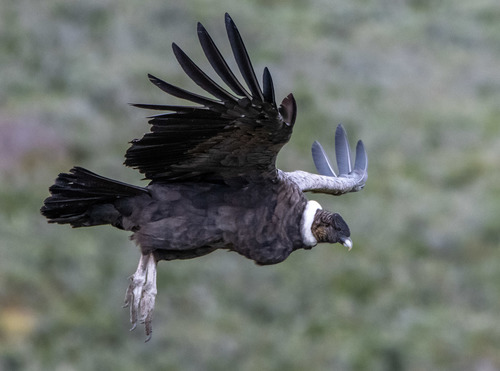
Andean Condor
The Andean Condor (*Vultur gryphus*) is a magnificent South American bird of prey, renowned for its immense size and soaring flight. It plays a crucial ecological role as a scavenger, efficiently recycling carrion and preventing the spread of disease. This species holds significant cultural importance for many Andean indigenous peoples, often symbolizing power, health, and freedom, and appearing in traditional folklore and art.
100-130 cm
Length
270-320 cm
Wingspan
Vulnerable
Conservation Status
Distribution
The Andean Condor is found along the Andes mountain range in South America, spanning Venezuela, Colombia, Ecuador, Peru, Bolivia, Chile, and Argentina. It can range from sea level to elevations of 5,000 meters (16,000 feet).
Lifespan
Wild Andean Condors can live for 50 years or more, with some captive individuals exceeding 70 years.
Andean Condor's Habitat
Habitat Types
Mountain grasslands, High-altitude open scrubland, Rocky cliffs, Coastal areas (in some regions)
Climate Zones
Temperate, Alpine
Adaptations
Their broad wings and soaring flight capabilities are perfectly adapted for riding thermal air currents in mountainous terrain. They possess strong beaks and claws for tearing flesh, and their bald heads are hygienic adaptations for feeding on carrion.
Variations
No recognized subspecies exist.
Appearance
Breeding Plumage
Adult plumage is largely uniform throughout the year.
Seasonal Feather Changes
No significant seasonal variations.
Sex Based Plumage Differences
Adult males have a large caruncle (comb) on their head and a wattle on their neck, which are absent in females. Females have red eyes, while males have brown eyes.
Notable Features
Large, fleshy caruncle on the head (males), White neck ruff, Mostly black plumage with white patches on the wings (adults), Bald head (adaptation for hygiene)
Diet and Feeding
Primary Foods
Carrion (dead animals), Large mammals (e.g., deer, cattle, guanacos), Marine animals (e.g., seals, whales) in coastal areas
Foraging Behavior
Andean Condors are primarily scavengers, soaring high above the ground to locate carcasses using their keen eyesight. They often rely on other scavengers, like smaller vultures, to initially open the carcass.
Specializations
Their strong beaks are adapted for tearing through tough hides. Their bald heads prevent feathers from becoming soiled with blood and other fluids.
Seasonal Diet Variations
Diet can vary depending on the availability of carcasses, which may be influenced by seasonal factors like animal migrations or breeding seasons.
Behavior
Social Structure
Andean Condors are generally solitary or found in small groups, especially when feeding at carcasses. They can form larger roosting groups.
Communication
Hissing and grunting sounds (primarily during feeding), Visual displays (e.g., wing postures)
Migration
Andean Condors are not truly migratory, but they may undertake significant movements within their range in search of food.
Territorial or Group Behaviors
They are not highly territorial, but may defend feeding areas around a carcass.
Conservation
Threats
Habitat loss and degradation, Poisoning (often indirect, from consuming poisoned carcasses intended for predators), Persecution by humans (due to perceived threats to livestock), Lead poisoning (from ingesting lead shot in carcasses)
Protection Programs
Captive breeding and reintroduction programs, Habitat protection and restoration, Public awareness campaigns, Research and monitoring
Local National Laws
Protected under national legislation in many Andean countries. Listed in CITES Appendix I, prohibiting international trade.
Population Trend
Decreasing
Population Estimates
The global population is estimated to be around 6,700 mature individuals.
Interesting Facts
The Andean Condor has one of the largest wingspans of any flying bird.
This allows them to soar effortlessly on thermal air currents.
They can fly without flapping their wings for hours.
Their large wingspan and mastery of soaring flight conserve energy.
They are among the longest-lived birds in the world.
Their slow maturation and low reproductive rate contribute to their long lifespan.
Juvenile Andean Condors have brown plumage.
It takes around six to eight years before fully mature, black-and-white adult plumage.
Faqs about Andean Condor
Are Andean Condors dangerous to humans?
No, Andean Condors are scavengers and pose no threat to humans. They are generally shy and avoid human contact.
Do Andean Condors kill livestock?
While they may occasionally feed on stillborn or very weak livestock, they primarily feed on already deceased animals. Reports of them killing healthy livestock are largely unfounded.
How can I help protect Andean Condors?
Supporting conservation organizations working to protect their habitat, advocating for responsible land management practices, and raising awareness about the importance of these birds are all helpful actions.
Copyright @ Nature Style Limited. All Rights Reserved.
 English
English